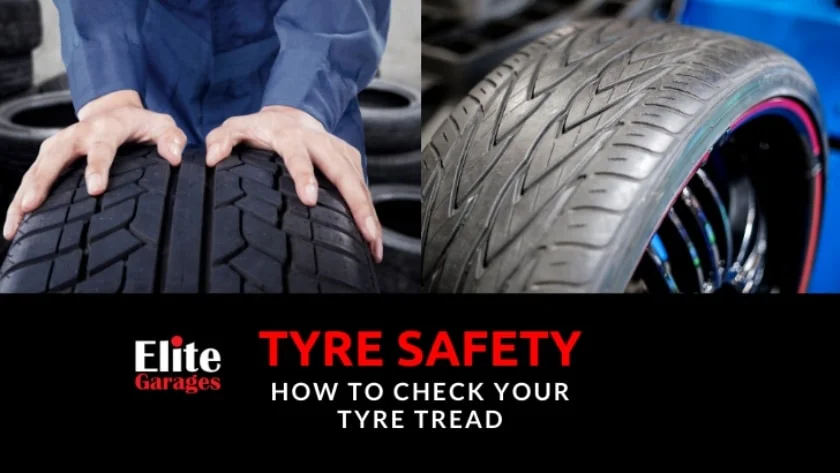
Checking Your Tyre Tread And Tyre Tread Depth
We’ve spoken at length about winter safety and checking your tyre tread forms an essential part. Even if your car feels normal when driving in dry conditions, tyres that are worn even slightly below the minimum legal limit can be extremely dangerous on wet and icy roads.
It also doesn’t matter what car you have or how well you think you drive, tyre experts recommend checking your tyres at least once a month and whenever you go on longer journeys. This applies to everyone whether you drive a few miles every week to the shops, on school runs or to and from work.
Laws in the UK and Europe state that the legal tyre tread depth for cars is 1.6mm across the central three-quarters of the tyre. To meet this requirement, your whole tyre needs to have the minimum tyre tread depth. Find out all you need to know about how quality tyres can help you stay safe this winter.
Tyre Tread And Stopping Distances
According to tests by UK technical organisation, MIRA, once tyres go below 3mm, stopping distances increase dramatically. They found that the difference in wet braking distance between a tyre worn to 3mm compared to 1.6mm can be as much as 44%.
For that reason, tyre and safety experts believe the minimum level should be 3mm to greatly improve road safety. With a lot of wet and cold conditions in the UK, it’s best to replace your tyres once the tread depth reaches 3mm.
Worn tyres are particularly dangerous in wet conditions as the tread helps move water away from the contact patch between the tyre and road. When there is less tread, the tyres can’t disperse sufficient water which results in a loss of grip and aquaplaning. In simple terms, deeper tread means more grip so make sure you check your tyre tread by following these simple tips.
How To Check Your Tyre Tread
Probably one of the easiest ways to check your tyre tread is with a tread depth gauge. This device will measure the inside and outside of your tread and can be purchased at most auto care centres.
Another method of checking tyre tread is by looking at the tread wear indicators. All tyre manufacturers add these into the grooves which makes it easier to identify worn tyres. It’s simple really – if the tread is level with the indicators, it’s time to replace your tyres.
The third and very popular method is the 20p coin test. All you have to do is insert a 20p coin into the main tread grooves and if you can’t see the outer band, your tyre tread is fine. However, if you can see the outer band of the coin, you should likely replace your tyres.
The Importance Of Checking Tyre Pressure
Checking your tread should be coupled with tyre pressure as many don’t realise how important it is to the overall integrity of your tyres. For accurate results, make sure you have a pressure gauge that uses the same unit of measurement as the guidelines given for your car. From there, simply follow these tips on how to check tyre pressure:
- Remove the dust caps from the tyre valve and place the pressure gauge onto the valve stem
- Press down the gauge evenly to ensure you get an accurate measurement
- Check the reading to see whether you need to inflate or deflate your tyres
- If they need inflating, use a suitable pump and don’t over-inflate
- To release air when deflating tyres, use the tip of a flat-head screwdriver or any thin, blunt object to push the metal pin on the valve stem
- Remember to take regular measurements between inflating and deflating
- Check the tyre tread and pressure on all four tyres and the spare as it can vary significantly
Is It Illegal To Drive On Worn Tyres?
This is a common question with a very simple answer. Not only are worn tyres a serious safety risk but it can be costly as well. In the UK, getting caught driving on worn tyre tread can result in a £2,500 fine along with three points on your licence. If you are caught driving with all four tyres below the minimum legal tyre tread depth, you could lose your licence and face a £10,000 fine.
Another issue when driving on worn tyres is insurance. If you are in an accident and the tyre tread is low, any subsequent insurance claims could be invalidated. This means they may refuse to pay for repairs to your vehicle or an injury claim.
Get A Grip With Better Tyres
Whether your tyres are under-inflated, over-inflated or worn down, you are putting yourself, your family and other road users at risk. Worn tyre tread and incorrectly inflated tyres can result in faster wear and tear, increased fuel consumption and reduced driving ability.
Fitting poorly remoulded or cheap tyres can also add to the risk, especially during warmer summer temperatures or colder winter weather. Higher quality tyres offer more grip, a longer lifespan and better fuel economy which is what our extensive tyre range is all about.
Why Choose Tyres From Elite Garages?
For improved safety, always choose quality tyres from Elite Garages as we are one of the UK’s leading fast-fit retailers and forecourt operators. We’re also a member of Group Tyre and represent more than 15% of the total tyres sold in the UK.
All of our service centres have friendly, professional and expertly-trained technicians who will make sure your tyre tread meets the mark. Whether you want winter tyres, general-use tyres or performance tyres, we’ve got over 1 million in stock across the Elite group.
For your convenience, you can also reserve tyres online and request a FREE tyre check at any of our branches to help prepare you for winter. Contact your nearest Elite branch if you have any questions about your tyre tread, MOTs, vehicle servicing or any other our other offers.
About Us
Opening Times
Saturday : 8:30–4:00
Sunday : closed
More Information
Contact UsCustomer Information Pack
Check MOT Due Date
Free MOT reminder
Careers


